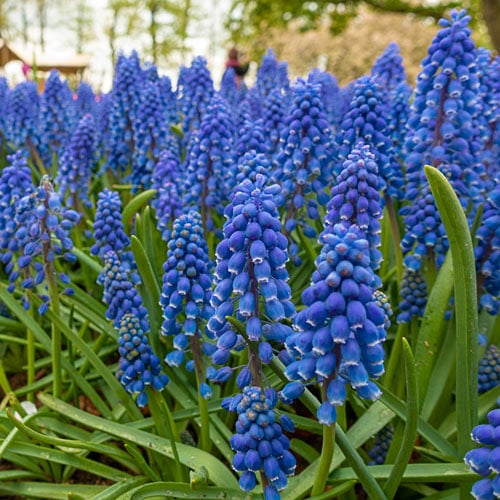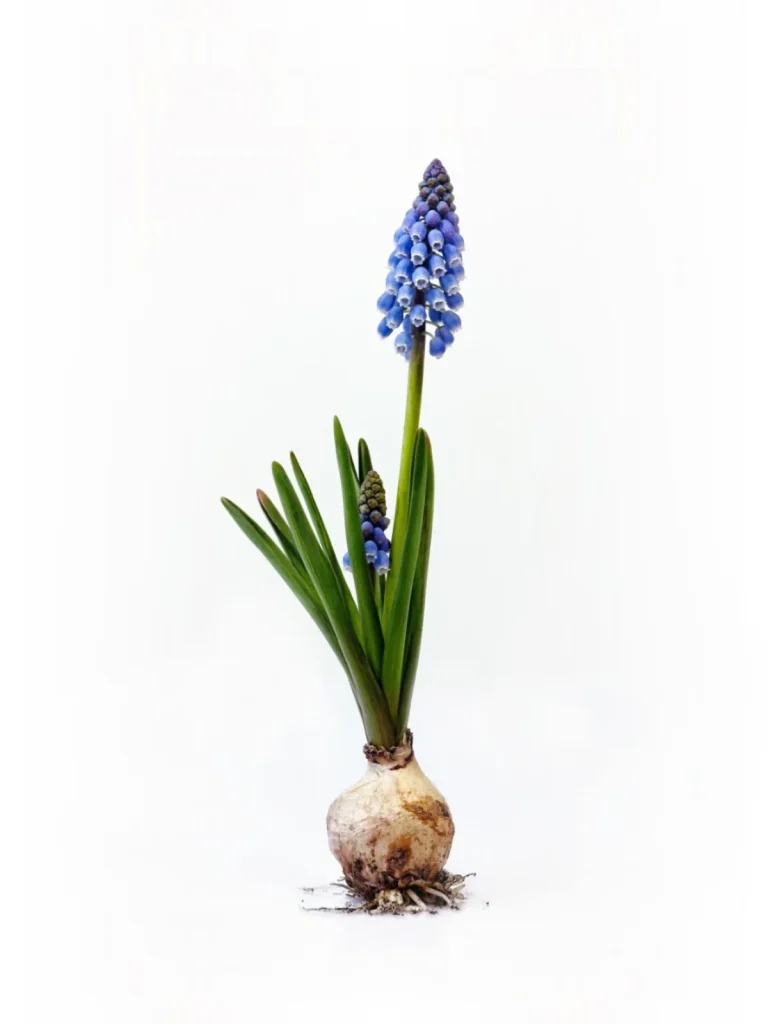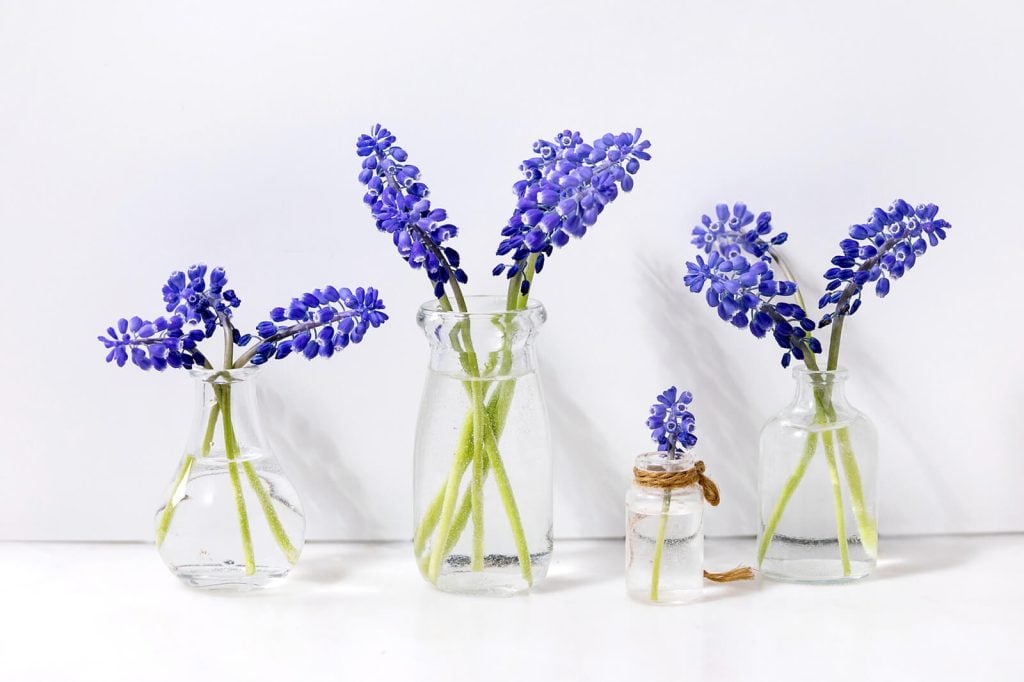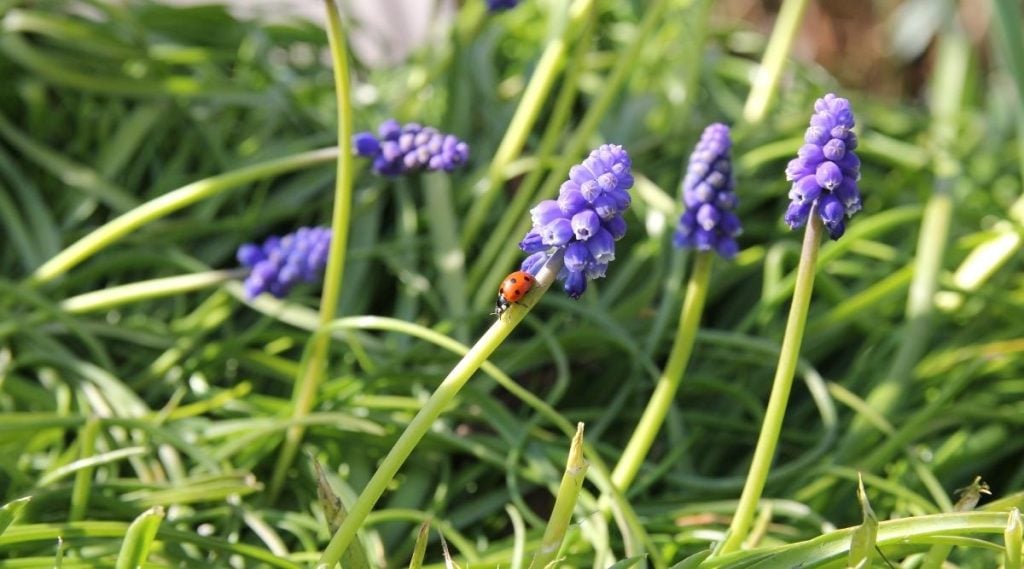Table of Contents
With around 40 diverse species, the perennial bulb genus Grape hyacinths also referred to as Muscari, is primarily found in the northern regions of Africa, Eurasia, and the Mediterranean basin. The flower clusters of this plant contain closely arranged urn-shaped florets that bear a resemblance to a small bunch of grapes, which is why they are commonly known by that descriptive name. These plants usually grow to a height of six to twelve inches and produce one to three flower spikes in the early to mid-spring. Their flowers blossom in a variety of colours, such as blue, purple, etc., and some species exhibit dual-toned colours. The flowers emit a delicate scent that has a subtle fruity touch. They bloom sequentially from the bottom of the raceme, with each floret unfurling to reveal a tiny fringe of tepals.
If you love growing plants and are looking to cultivate something delightful and easy to care for? Muscari is your answer!
Our informative blog post covers the entire process of growing Muscari, so you can start right away.
How to Grow Muscari
Muscari plants are classically elegant and effortless to care for and small. You can plant them in the fall and then forget all about them for several months until they spring up from the earth and add a bright pop of colour to your otherwise dull early-spring garden.
Muscari is quite low-maintenance and does not demand much attention. Even though it flourishes in full sunlight, it can endure partial shade. This shouldn’t be an issue considering that several trees would not have yet acquired their leaves in the early spring and that the majority of gardens obtain plenty of sunshine to maintain the happiness of Muscari plants.
As soon as flowers fade, trim them with scissors, but let the stalks nurture the bulb. During the fall, it’s best to add compost to your bulbs without worrying about any leaf growth. This is actually a good sign that your bulbs are acquiring more nourishment. It will allow them to return to their original state naturally.
When it comes to the grape hyacinth U.k, adding only a minor amount of fertilizer before and during blossoming is necessary. After the flowers have finished blooming, it is crucial to mix compost into the soil. The bulb remains in the soil and can retain nutrients throughout the year and bloom more magnificently the next spring.
Planting Muscari

Like many other spring-flowering bulbs, Muscaris are ideally planted in the fall. If you want to protect your Muscaris, it’s important you plant them in soil that drains well. Because if you plant them in a wet area, then the bulbs may decay.
Muscari bulbs, like other small blooming bulb varieties, create the most beautiful sight when planted in large groups. To create a small garden, begin by planting at least 25 plants in a cluster. And for a city garden, you must plant a minimum of 100 flowers or disperse them across the ground beneath trees and bushes. Since the bulbs are reasonably priced, it is worthwhile investing in sizable, high-quality ones that generate about five flower stems per bulb because bulbs of poor quality will only produce two to three flowers.
It is possible to cultivate Muscari plants indoors, although the procedure is a little more complicated. To get started, you’ll need a pot that’s at least 3 inches deep, loosely filled with potting mix.
Next, position the bulbs on top of the mixture with their pointed ends facing upward, but avoid pushing them too far into the soil, as this may hinder the roots from growing. Add a little more potting mix, ensuring that you don’t cover the tips. Once you have thoroughly watered and drained the pot, you should place it in a dark and cool place (around 40 °F) for approximately ten weeks. Basements work well for this, but be sure to keep the surroundings moderately humid.
Once the sprouts grow to about 2 inches, shift the pot to a warmer spot, around 50°F. From now on, you should make sure to increase watering the plant to maintain soil moisture levels and gradually shift the plant to warmer locations until it is fully bloomed. Following that, you can move it to a brightly lit space but keep it away from direct sunlight.
Watering Muscari
During the spring, Muscaris need plenty of moisture. However, as the season changes, it’s best to allow the soil to dry a bit. Implementing this technique when the bulbs are not in bloom is beneficial in preventing bulb rot.
Muscari plants need ample water when exposed to direct sunlight. But you should be sure to steer clear of waterlogging at all times! Excess water in the soil will cause the flower bulb to decay, eventually resulting in the death of the flower.
On rainy spring days, plants receive adequate nourishment from the rainwater. It’s only during extended droughts that you should consider increasing the frequency of watering. During moderate climates, it is best to water them approximately two times a week.

Propagation
Muscaris are quick and efficient at naturalizing and reproducing in the garden through bulb offsets and self-seeding.
However, it takes a minimum of 4 years for seed-propagated plants to bloom. Since bulbs tend to multiply and flower easily, offsets are the preferred means of propagation.
1. From Seed
- During the summer, you can harvest seeds by removing the dried seed pods.
- After removing them, place the seeds onto a damp paper towel and put the towel inside a plastic bag that is loosely sealed.
- For germination, store the bag in the fridge for at most three months. In order for Muscari seeds to sprout, they must first undergo cold stratification – a process of exposing them to cold and moist conditions to release them from dormancy.
- After about eight to 12 weeks, seeds will start to sprout in the refrigerator.
- Once the danger of frost has subsided in the spring, transplant your plant seedlings from sterile garden mix into trays and subsequently move them out into the garden.
2. From Bulbs
- For the best results, you may plant bulbs in groups of 25 or more during the fall or spring. When these flowers are bunched together in generous amounts, they create a beautiful visual effect. When planted individually or in small groups, they may appear sparse due to their compact size.
- For better drainage, you can consider mixing one-third of organic matter (such as aged compost or manure) with one-third of sand or fine pebble grit into your planting soil.
- To aid in root development, add a small amount of bone meal while planting.
- To ensure correct positioning, place the bulbs with their flat end down, keeping a one to two-inch gap between them and planting them at one to two inches deep. Finally, gently tamp the soil around the bulbs.
- Lightly water the bulbs to ensure that they settle well.
3. By Bulb Offset
- The best time to divide clumps of muscari is either in early spring prior to plant growth or in early fall when the leaves have decayed, and the plants are dormant.
- To begin with, you must carefully unearth clusters of plants and gently detach offshoots from the main bulbs.
- Pick the largest and healthiest bulbs and replant them where desired. Planting mid-sized bulbs in clusters is a great way to establish new bunches of flowers.
- You can scatter the small remaining bulbs on bare spots, rocky areas, or grassy fields and meadows to let them grow without constraints.
- Be careful when getting rid of the leftovers because they tend to multiply rapidly and abundantly. Make sure not to dispose of them in undesired locations.
After-Bloom Care and Maintenance

For those looking for a low-maintenance option, muscari bulbs are perfect, with minimal care needed.
The foliage begins to wither and die back in late spring. Once the leaves have dried and turned brown, use a small hand rake to remove them.
These bulbs do not require additional feeding when planted in beds, but if grown in containers, a 5-10-5 granular fertilizer should be applied lightly in late winter before blooming.
Cultivars to Select
There are many different grape hyacinth uk options to choose from. It includes Dark Eyes, Delft Blue Mix, Pink Sunrise, White Magic, and more. If you are seeking the easiest-to-manage variety, Dark Eyes are a viable option, as they can flourish in full or partial sunlight and are fairly adaptable to a variety of soil types.
Pests and Diseases

You usually don’t have to worry about pests or diseases affecting grape hyacinths. But their beautiful blossoms can draw aphids and spider mites sometimes. Although these pests are typically easy to manage and not a major issue, they have the potential to spread the Yellow Mosaic Virus. If the plant is attacked by the virus, then they are bound to devastate since there is no cure for the virus attack.
Fortunately, controlling infestations of both aphids and spider mites is an easy task. You can easily pluck them off, crush them with your fingers, or toss them into a jar filled with soapy water. Besides, certain insects, such as ladybugs, serve as natural predators of aphids and spider mites. Introducing them can be beneficial for the growth of the plant.
Lastly, Yellow Mosaic Viruses, aphids, and spider mites, grape hyacinth uk are vulnerable to bulb rot, especially when they are exposed to too much water. To prevent this issue from arising, it is essential to avoid overwatering the plants and plant them in well-draining soil that is slightly sandy.
Conclusion
Muscari is a popular plant commonly used to signify the start of spring. These colourful flowers are a breeze to grow and require minimal upkeep, making them perfect for those who tend to plant and neglect them.
We have provided you with a comprehensive guide to growing and caring for Muscari, covering all aspects of the process.
Are you going to grow Muscari in your garden? Share your thoughts in the comment section!
Frequently Asked Questions
Are Grape Hyacinths Poisonous?
No, grape hyacinths are not poisonous. Instead, they are edible plants that are used in multiple Greek and Italian dishes. Be careful not to mistake grape hyacinths for hyacinths, which are poisonous to both humans and animals.
Do Grape Hyacinths Come Back Every Year?
By providing the right care, it’s possible for these perennial flowers to bloom every year during springtime.
How Long Do Grape Hyacinths Bloom?
The grape hyacinth blooms for approximately three weeks. Sadly, it is not feasible to coax them into blooming again within the same season. You won’t be able to see them flower again until next year.
What Eats Grape Hyacinths?
If you notice damage to your grape hyacinth uk, it could be caused by insects, slugs, snails, or mammals. Although they are not commonly preferred by any particular animal, there may be instances where they are.
Is Grape Hyacinth Edible?
Yes, grape hyacinths are edible. If you’re interested in cooking with grape hyacinth, there are plenty of recipes available online. For instance, you can use the flowers of grape hyacinth to make a sort of syrup for lemonade, etc.

![Growing Muscari “Grape Hyacinth”: From Planting to Maintenance [UK] How To Grow Muscari + Care Guidelines](https://www.thearches.co.uk/wp-content/uploads/How-To-Grow-Muscari-Care-Guidelines.jpeg)



